Community Mapping and Needs Assessment Report: Aboriginal Community
VerifiedAdded on 2022/11/17
|9
|2410
|368
Report
AI Summary
This report provides a comprehensive community mapping and needs assessment of the Australian Aboriginal community. It begins with an introduction discussing the unique characteristics, cultural aspects, and legal structures of the Aboriginal people, highlighting their historical struggles and marginalization. The report then delves into community mapping, outlining the challenges faced, particularly since colonialism, including issues of identity, rights, and transgenerational trauma. A detailed needs assessment is conducted, focusing on the community's demands for political representation, cultural preservation, resource access, education, and improved health and wellbeing. The report prioritizes these needs, sets community goals, and concludes by emphasizing the importance of research, information gathering, effective communication, and survey methods to address the community's challenges and achieve their goals, ultimately aiming to bridge existing gaps in various aspects of their lives.
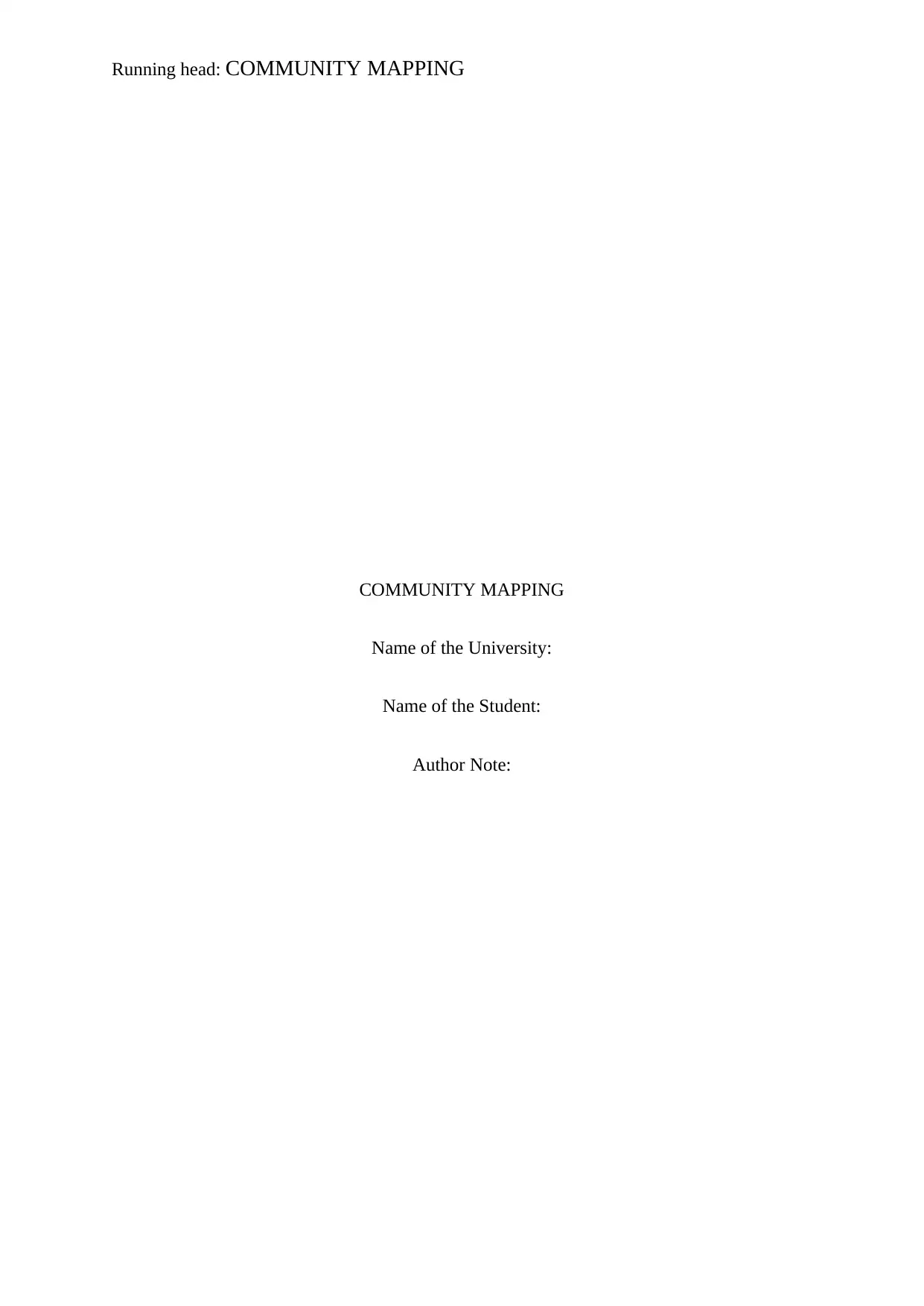
Running head: COMMUNITY MAPPING
COMMUNITY MAPPING
Name of the University:
Name of the Student:
Author Note:
COMMUNITY MAPPING
Name of the University:
Name of the Student:
Author Note:
Paraphrase This Document
Need a fresh take? Get an instant paraphrase of this document with our AI Paraphraser
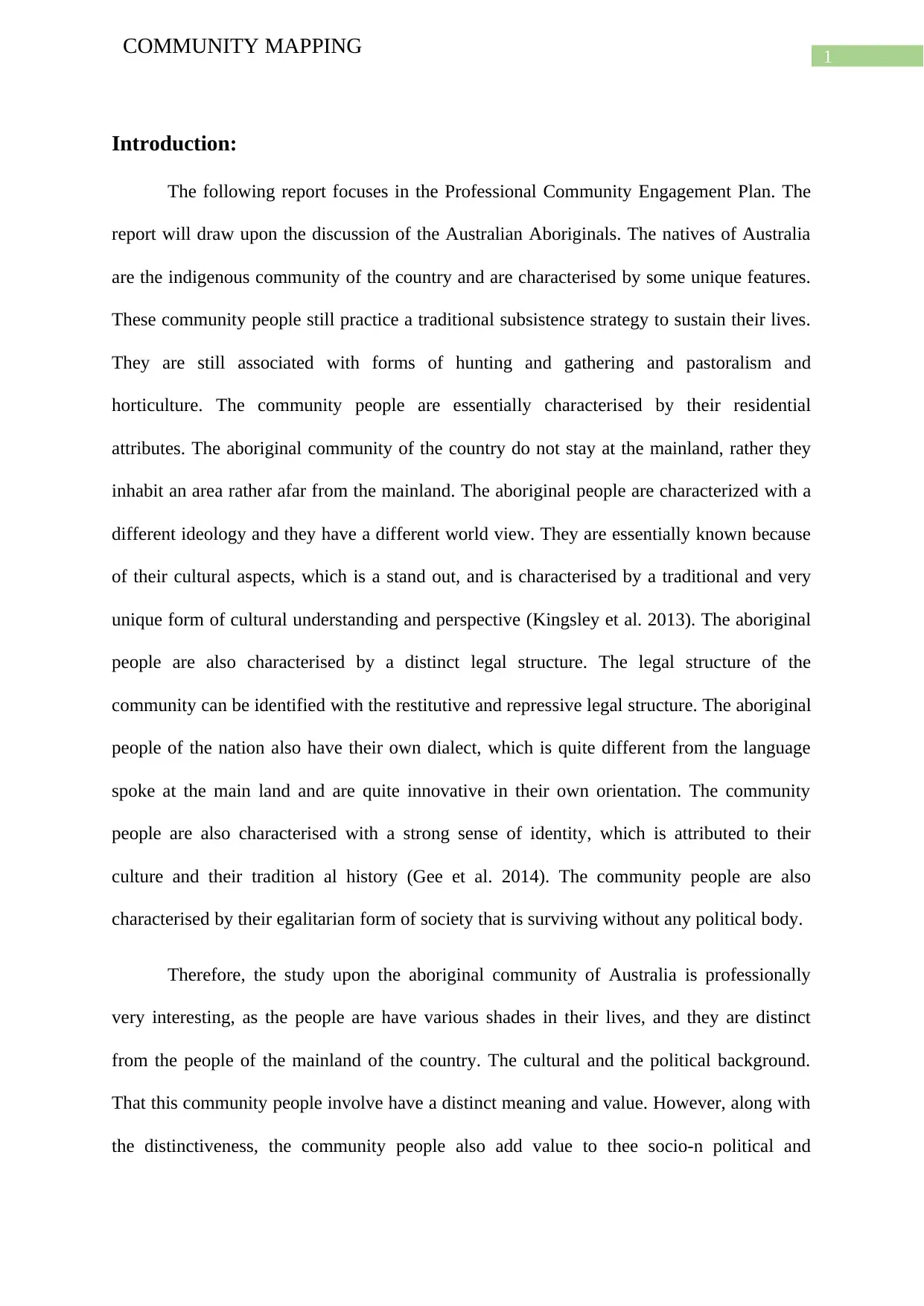
1
COMMUNITY MAPPING
Introduction:
The following report focuses in the Professional Community Engagement Plan. The
report will draw upon the discussion of the Australian Aboriginals. The natives of Australia
are the indigenous community of the country and are characterised by some unique features.
These community people still practice a traditional subsistence strategy to sustain their lives.
They are still associated with forms of hunting and gathering and pastoralism and
horticulture. The community people are essentially characterised by their residential
attributes. The aboriginal community of the country do not stay at the mainland, rather they
inhabit an area rather afar from the mainland. The aboriginal people are characterized with a
different ideology and they have a different world view. They are essentially known because
of their cultural aspects, which is a stand out, and is characterised by a traditional and very
unique form of cultural understanding and perspective (Kingsley et al. 2013). The aboriginal
people are also characterised by a distinct legal structure. The legal structure of the
community can be identified with the restitutive and repressive legal structure. The aboriginal
people of the nation also have their own dialect, which is quite different from the language
spoke at the main land and are quite innovative in their own orientation. The community
people are also characterised with a strong sense of identity, which is attributed to their
culture and their tradition al history (Gee et al. 2014). The community people are also
characterised by their egalitarian form of society that is surviving without any political body.
Therefore, the study upon the aboriginal community of Australia is professionally
very interesting, as the people are have various shades in their lives, and they are distinct
from the people of the mainland of the country. The cultural and the political background.
That this community people involve have a distinct meaning and value. However, along with
the distinctiveness, the community people also add value to thee socio-n political and
COMMUNITY MAPPING
Introduction:
The following report focuses in the Professional Community Engagement Plan. The
report will draw upon the discussion of the Australian Aboriginals. The natives of Australia
are the indigenous community of the country and are characterised by some unique features.
These community people still practice a traditional subsistence strategy to sustain their lives.
They are still associated with forms of hunting and gathering and pastoralism and
horticulture. The community people are essentially characterised by their residential
attributes. The aboriginal community of the country do not stay at the mainland, rather they
inhabit an area rather afar from the mainland. The aboriginal people are characterized with a
different ideology and they have a different world view. They are essentially known because
of their cultural aspects, which is a stand out, and is characterised by a traditional and very
unique form of cultural understanding and perspective (Kingsley et al. 2013). The aboriginal
people are also characterised by a distinct legal structure. The legal structure of the
community can be identified with the restitutive and repressive legal structure. The aboriginal
people of the nation also have their own dialect, which is quite different from the language
spoke at the main land and are quite innovative in their own orientation. The community
people are also characterised with a strong sense of identity, which is attributed to their
culture and their tradition al history (Gee et al. 2014). The community people are also
characterised by their egalitarian form of society that is surviving without any political body.
Therefore, the study upon the aboriginal community of Australia is professionally
very interesting, as the people are have various shades in their lives, and they are distinct
from the people of the mainland of the country. The cultural and the political background.
That this community people involve have a distinct meaning and value. However, along with
the distinctiveness, the community people also add value to thee socio-n political and
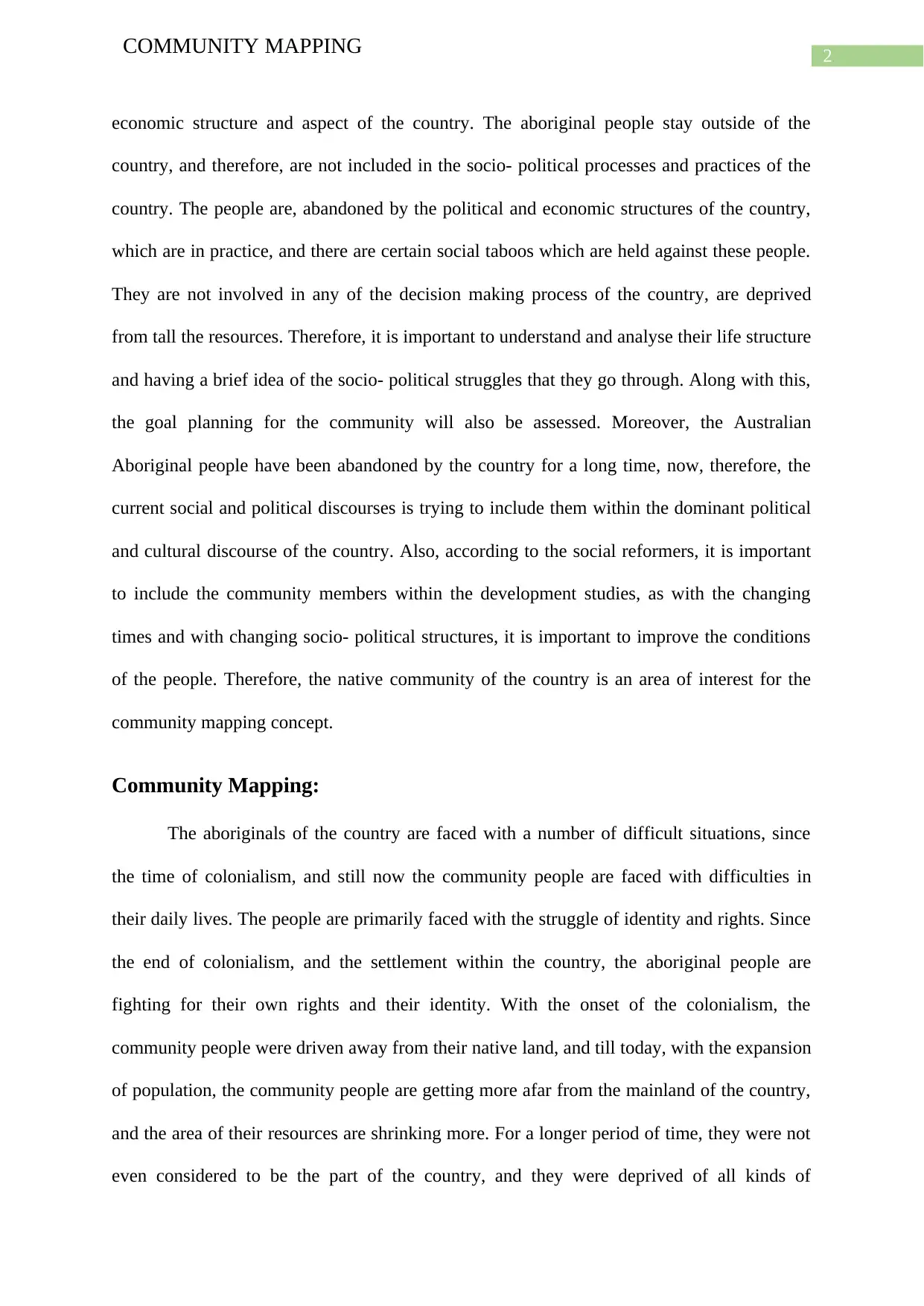
2
COMMUNITY MAPPING
economic structure and aspect of the country. The aboriginal people stay outside of the
country, and therefore, are not included in the socio- political processes and practices of the
country. The people are, abandoned by the political and economic structures of the country,
which are in practice, and there are certain social taboos which are held against these people.
They are not involved in any of the decision making process of the country, are deprived
from tall the resources. Therefore, it is important to understand and analyse their life structure
and having a brief idea of the socio- political struggles that they go through. Along with this,
the goal planning for the community will also be assessed. Moreover, the Australian
Aboriginal people have been abandoned by the country for a long time, now, therefore, the
current social and political discourses is trying to include them within the dominant political
and cultural discourse of the country. Also, according to the social reformers, it is important
to include the community members within the development studies, as with the changing
times and with changing socio- political structures, it is important to improve the conditions
of the people. Therefore, the native community of the country is an area of interest for the
community mapping concept.
Community Mapping:
The aboriginals of the country are faced with a number of difficult situations, since
the time of colonialism, and still now the community people are faced with difficulties in
their daily lives. The people are primarily faced with the struggle of identity and rights. Since
the end of colonialism, and the settlement within the country, the aboriginal people are
fighting for their own rights and their identity. With the onset of the colonialism, the
community people were driven away from their native land, and till today, with the expansion
of population, the community people are getting more afar from the mainland of the country,
and the area of their resources are shrinking more. For a longer period of time, they were not
even considered to be the part of the country, and they were deprived of all kinds of
COMMUNITY MAPPING
economic structure and aspect of the country. The aboriginal people stay outside of the
country, and therefore, are not included in the socio- political processes and practices of the
country. The people are, abandoned by the political and economic structures of the country,
which are in practice, and there are certain social taboos which are held against these people.
They are not involved in any of the decision making process of the country, are deprived
from tall the resources. Therefore, it is important to understand and analyse their life structure
and having a brief idea of the socio- political struggles that they go through. Along with this,
the goal planning for the community will also be assessed. Moreover, the Australian
Aboriginal people have been abandoned by the country for a long time, now, therefore, the
current social and political discourses is trying to include them within the dominant political
and cultural discourse of the country. Also, according to the social reformers, it is important
to include the community members within the development studies, as with the changing
times and with changing socio- political structures, it is important to improve the conditions
of the people. Therefore, the native community of the country is an area of interest for the
community mapping concept.
Community Mapping:
The aboriginals of the country are faced with a number of difficult situations, since
the time of colonialism, and still now the community people are faced with difficulties in
their daily lives. The people are primarily faced with the struggle of identity and rights. Since
the end of colonialism, and the settlement within the country, the aboriginal people are
fighting for their own rights and their identity. With the onset of the colonialism, the
community people were driven away from their native land, and till today, with the expansion
of population, the community people are getting more afar from the mainland of the country,
and the area of their resources are shrinking more. For a longer period of time, they were not
even considered to be the part of the country, and they were deprived of all kinds of
⊘ This is a preview!⊘
Do you want full access?
Subscribe today to unlock all pages.

Trusted by 1+ million students worldwide
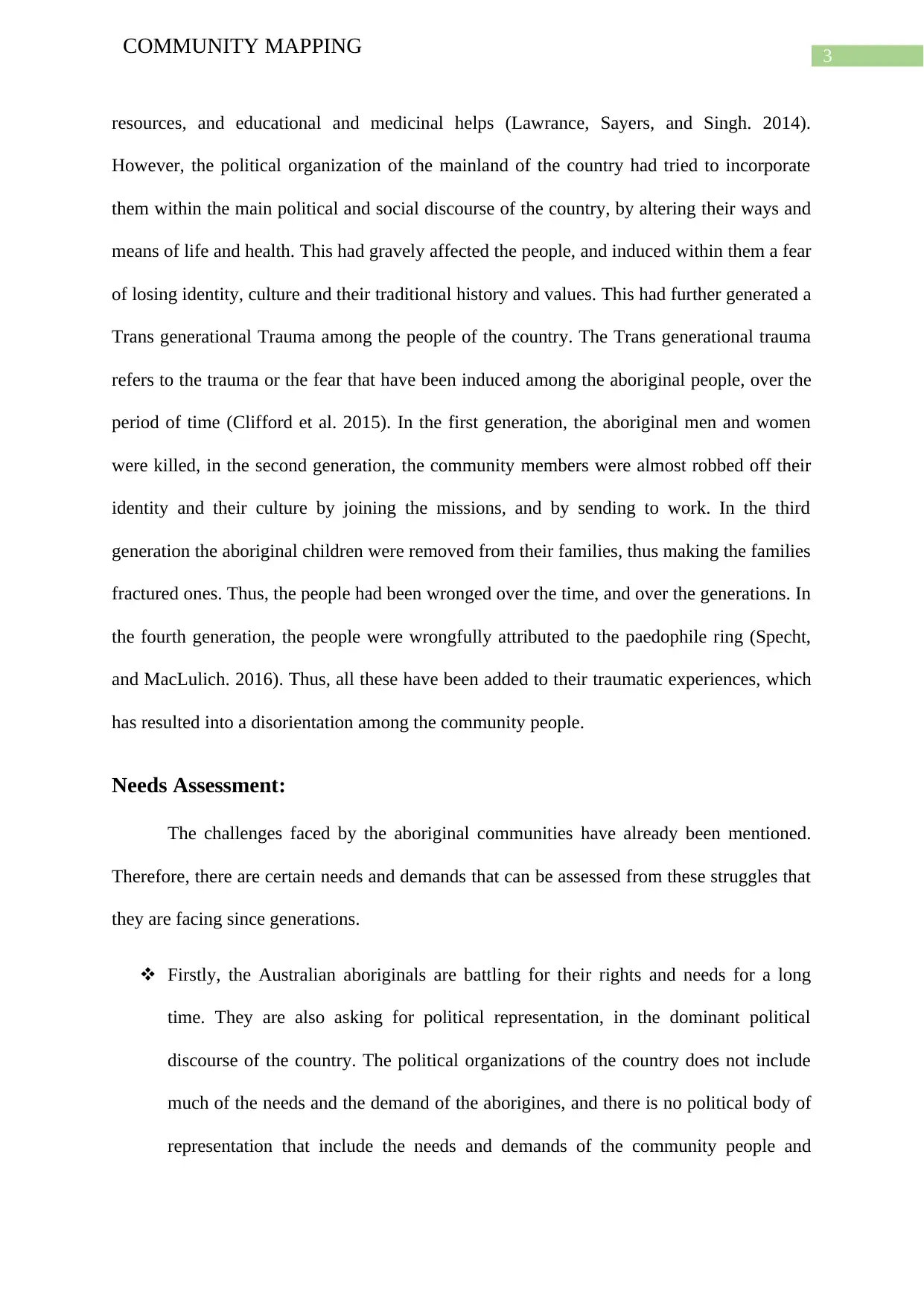
3
COMMUNITY MAPPING
resources, and educational and medicinal helps (Lawrance, Sayers, and Singh. 2014).
However, the political organization of the mainland of the country had tried to incorporate
them within the main political and social discourse of the country, by altering their ways and
means of life and health. This had gravely affected the people, and induced within them a fear
of losing identity, culture and their traditional history and values. This had further generated a
Trans generational Trauma among the people of the country. The Trans generational trauma
refers to the trauma or the fear that have been induced among the aboriginal people, over the
period of time (Clifford et al. 2015). In the first generation, the aboriginal men and women
were killed, in the second generation, the community members were almost robbed off their
identity and their culture by joining the missions, and by sending to work. In the third
generation the aboriginal children were removed from their families, thus making the families
fractured ones. Thus, the people had been wronged over the time, and over the generations. In
the fourth generation, the people were wrongfully attributed to the paedophile ring (Specht,
and MacLulich. 2016). Thus, all these have been added to their traumatic experiences, which
has resulted into a disorientation among the community people.
Needs Assessment:
The challenges faced by the aboriginal communities have already been mentioned.
Therefore, there are certain needs and demands that can be assessed from these struggles that
they are facing since generations.
Firstly, the Australian aboriginals are battling for their rights and needs for a long
time. They are also asking for political representation, in the dominant political
discourse of the country. The political organizations of the country does not include
much of the needs and the demand of the aborigines, and there is no political body of
representation that include the needs and demands of the community people and
COMMUNITY MAPPING
resources, and educational and medicinal helps (Lawrance, Sayers, and Singh. 2014).
However, the political organization of the mainland of the country had tried to incorporate
them within the main political and social discourse of the country, by altering their ways and
means of life and health. This had gravely affected the people, and induced within them a fear
of losing identity, culture and their traditional history and values. This had further generated a
Trans generational Trauma among the people of the country. The Trans generational trauma
refers to the trauma or the fear that have been induced among the aboriginal people, over the
period of time (Clifford et al. 2015). In the first generation, the aboriginal men and women
were killed, in the second generation, the community members were almost robbed off their
identity and their culture by joining the missions, and by sending to work. In the third
generation the aboriginal children were removed from their families, thus making the families
fractured ones. Thus, the people had been wronged over the time, and over the generations. In
the fourth generation, the people were wrongfully attributed to the paedophile ring (Specht,
and MacLulich. 2016). Thus, all these have been added to their traumatic experiences, which
has resulted into a disorientation among the community people.
Needs Assessment:
The challenges faced by the aboriginal communities have already been mentioned.
Therefore, there are certain needs and demands that can be assessed from these struggles that
they are facing since generations.
Firstly, the Australian aboriginals are battling for their rights and needs for a long
time. They are also asking for political representation, in the dominant political
discourse of the country. The political organizations of the country does not include
much of the needs and the demand of the aborigines, and there is no political body of
representation that include the needs and demands of the community people and
Paraphrase This Document
Need a fresh take? Get an instant paraphrase of this document with our AI Paraphraser
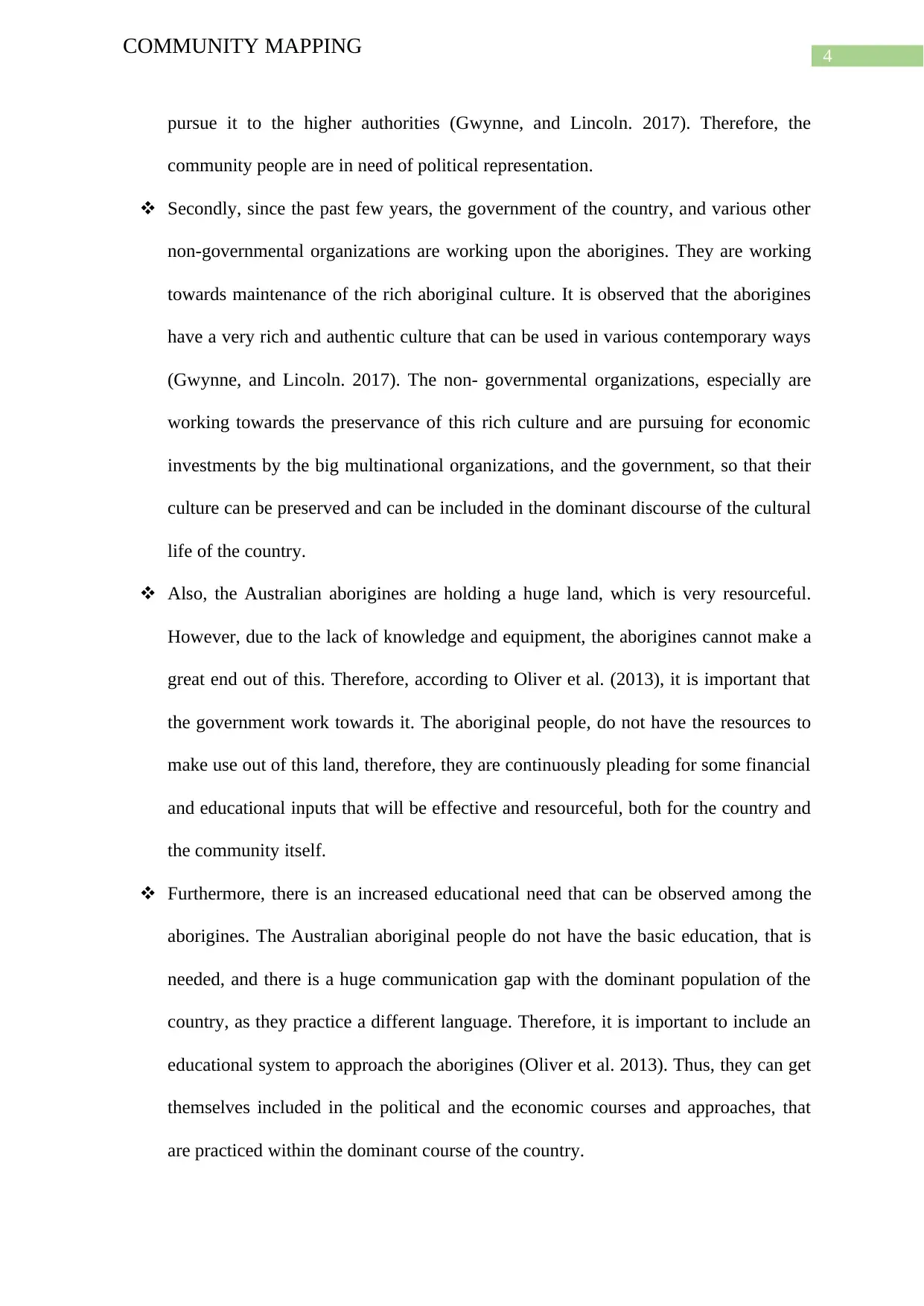
4
COMMUNITY MAPPING
pursue it to the higher authorities (Gwynne, and Lincoln. 2017). Therefore, the
community people are in need of political representation.
Secondly, since the past few years, the government of the country, and various other
non-governmental organizations are working upon the aborigines. They are working
towards maintenance of the rich aboriginal culture. It is observed that the aborigines
have a very rich and authentic culture that can be used in various contemporary ways
(Gwynne, and Lincoln. 2017). The non- governmental organizations, especially are
working towards the preservance of this rich culture and are pursuing for economic
investments by the big multinational organizations, and the government, so that their
culture can be preserved and can be included in the dominant discourse of the cultural
life of the country.
Also, the Australian aborigines are holding a huge land, which is very resourceful.
However, due to the lack of knowledge and equipment, the aborigines cannot make a
great end out of this. Therefore, according to Oliver et al. (2013), it is important that
the government work towards it. The aboriginal people, do not have the resources to
make use out of this land, therefore, they are continuously pleading for some financial
and educational inputs that will be effective and resourceful, both for the country and
the community itself.
Furthermore, there is an increased educational need that can be observed among the
aborigines. The Australian aboriginal people do not have the basic education, that is
needed, and there is a huge communication gap with the dominant population of the
country, as they practice a different language. Therefore, it is important to include an
educational system to approach the aborigines (Oliver et al. 2013). Thus, they can get
themselves included in the political and the economic courses and approaches, that
are practiced within the dominant course of the country.
COMMUNITY MAPPING
pursue it to the higher authorities (Gwynne, and Lincoln. 2017). Therefore, the
community people are in need of political representation.
Secondly, since the past few years, the government of the country, and various other
non-governmental organizations are working upon the aborigines. They are working
towards maintenance of the rich aboriginal culture. It is observed that the aborigines
have a very rich and authentic culture that can be used in various contemporary ways
(Gwynne, and Lincoln. 2017). The non- governmental organizations, especially are
working towards the preservance of this rich culture and are pursuing for economic
investments by the big multinational organizations, and the government, so that their
culture can be preserved and can be included in the dominant discourse of the cultural
life of the country.
Also, the Australian aborigines are holding a huge land, which is very resourceful.
However, due to the lack of knowledge and equipment, the aborigines cannot make a
great end out of this. Therefore, according to Oliver et al. (2013), it is important that
the government work towards it. The aboriginal people, do not have the resources to
make use out of this land, therefore, they are continuously pleading for some financial
and educational inputs that will be effective and resourceful, both for the country and
the community itself.
Furthermore, there is an increased educational need that can be observed among the
aborigines. The Australian aboriginal people do not have the basic education, that is
needed, and there is a huge communication gap with the dominant population of the
country, as they practice a different language. Therefore, it is important to include an
educational system to approach the aborigines (Oliver et al. 2013). Thus, they can get
themselves included in the political and the economic courses and approaches, that
are practiced within the dominant course of the country.
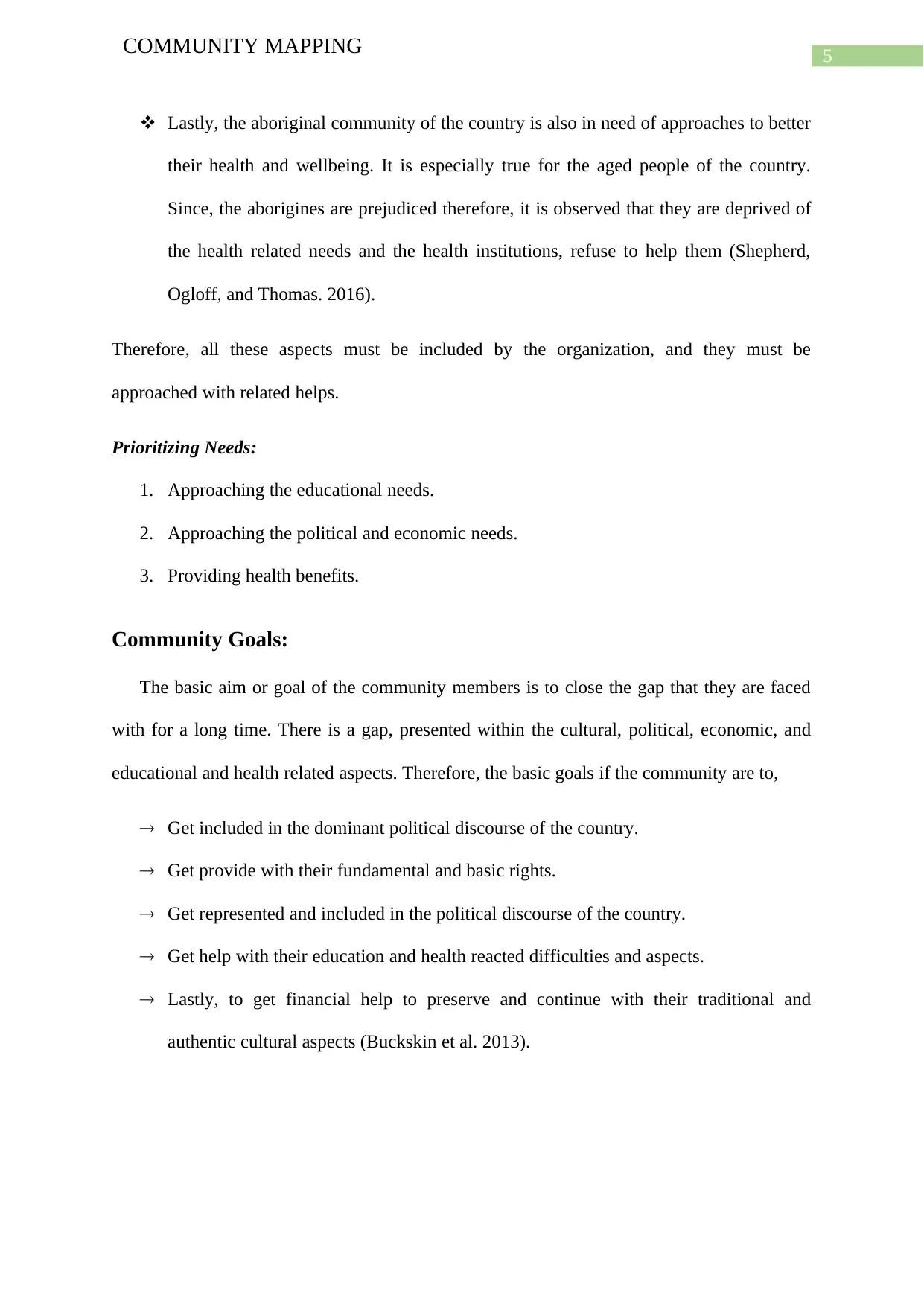
5
COMMUNITY MAPPING
Lastly, the aboriginal community of the country is also in need of approaches to better
their health and wellbeing. It is especially true for the aged people of the country.
Since, the aborigines are prejudiced therefore, it is observed that they are deprived of
the health related needs and the health institutions, refuse to help them (Shepherd,
Ogloff, and Thomas. 2016).
Therefore, all these aspects must be included by the organization, and they must be
approached with related helps.
Prioritizing Needs:
1. Approaching the educational needs.
2. Approaching the political and economic needs.
3. Providing health benefits.
Community Goals:
The basic aim or goal of the community members is to close the gap that they are faced
with for a long time. There is a gap, presented within the cultural, political, economic, and
educational and health related aspects. Therefore, the basic goals if the community are to,
Get included in the dominant political discourse of the country.
Get provide with their fundamental and basic rights.
Get represented and included in the political discourse of the country.
Get help with their education and health reacted difficulties and aspects.
Lastly, to get financial help to preserve and continue with their traditional and
authentic cultural aspects (Buckskin et al. 2013).
COMMUNITY MAPPING
Lastly, the aboriginal community of the country is also in need of approaches to better
their health and wellbeing. It is especially true for the aged people of the country.
Since, the aborigines are prejudiced therefore, it is observed that they are deprived of
the health related needs and the health institutions, refuse to help them (Shepherd,
Ogloff, and Thomas. 2016).
Therefore, all these aspects must be included by the organization, and they must be
approached with related helps.
Prioritizing Needs:
1. Approaching the educational needs.
2. Approaching the political and economic needs.
3. Providing health benefits.
Community Goals:
The basic aim or goal of the community members is to close the gap that they are faced
with for a long time. There is a gap, presented within the cultural, political, economic, and
educational and health related aspects. Therefore, the basic goals if the community are to,
Get included in the dominant political discourse of the country.
Get provide with their fundamental and basic rights.
Get represented and included in the political discourse of the country.
Get help with their education and health reacted difficulties and aspects.
Lastly, to get financial help to preserve and continue with their traditional and
authentic cultural aspects (Buckskin et al. 2013).
⊘ This is a preview!⊘
Do you want full access?
Subscribe today to unlock all pages.

Trusted by 1+ million students worldwide
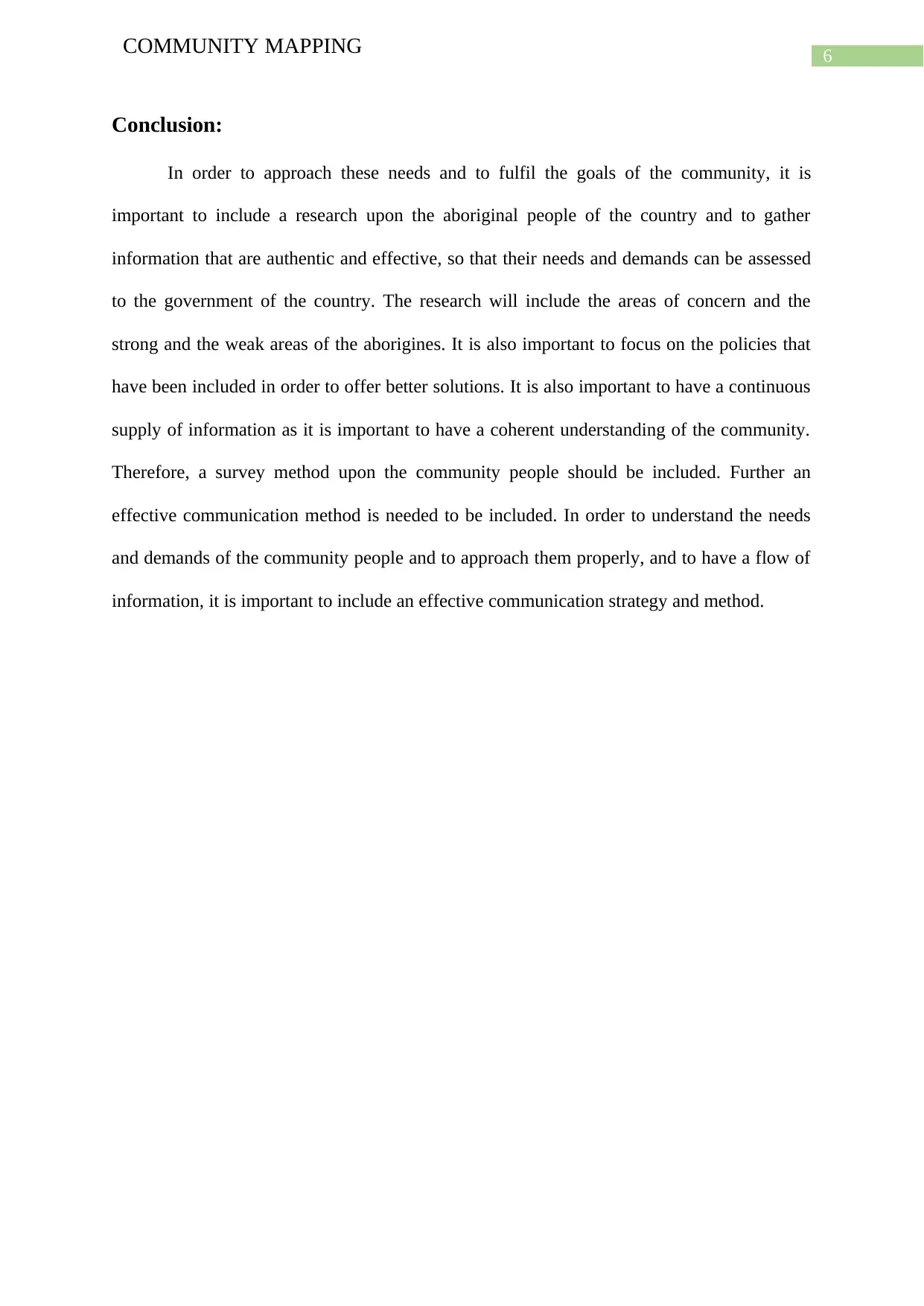
6
COMMUNITY MAPPING
Conclusion:
In order to approach these needs and to fulfil the goals of the community, it is
important to include a research upon the aboriginal people of the country and to gather
information that are authentic and effective, so that their needs and demands can be assessed
to the government of the country. The research will include the areas of concern and the
strong and the weak areas of the aborigines. It is also important to focus on the policies that
have been included in order to offer better solutions. It is also important to have a continuous
supply of information as it is important to have a coherent understanding of the community.
Therefore, a survey method upon the community people should be included. Further an
effective communication method is needed to be included. In order to understand the needs
and demands of the community people and to approach them properly, and to have a flow of
information, it is important to include an effective communication strategy and method.
COMMUNITY MAPPING
Conclusion:
In order to approach these needs and to fulfil the goals of the community, it is
important to include a research upon the aboriginal people of the country and to gather
information that are authentic and effective, so that their needs and demands can be assessed
to the government of the country. The research will include the areas of concern and the
strong and the weak areas of the aborigines. It is also important to focus on the policies that
have been included in order to offer better solutions. It is also important to have a continuous
supply of information as it is important to have a coherent understanding of the community.
Therefore, a survey method upon the community people should be included. Further an
effective communication method is needed to be included. In order to understand the needs
and demands of the community people and to approach them properly, and to have a flow of
information, it is important to include an effective communication strategy and method.
Paraphrase This Document
Need a fresh take? Get an instant paraphrase of this document with our AI Paraphraser
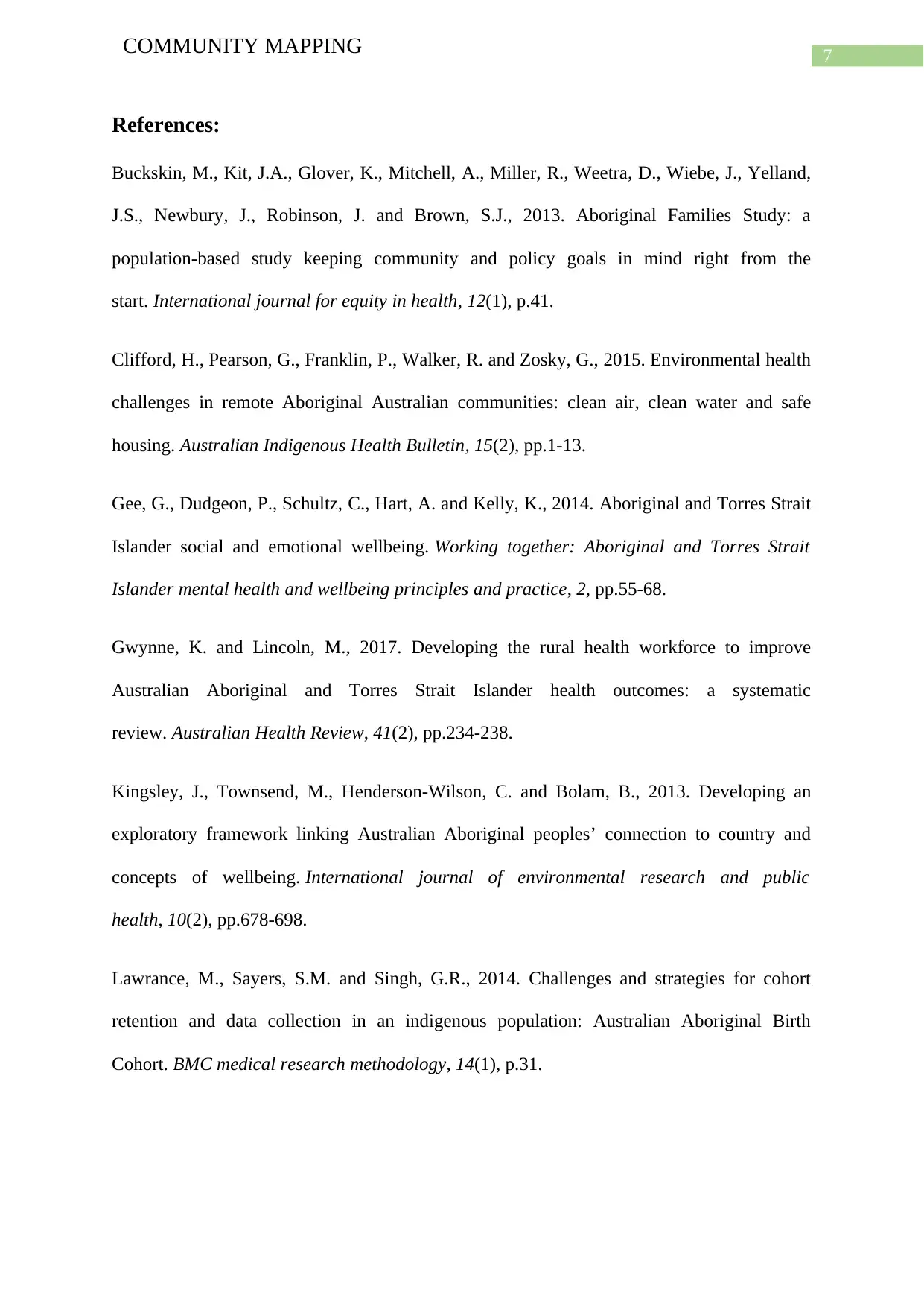
7
COMMUNITY MAPPING
References:
Buckskin, M., Kit, J.A., Glover, K., Mitchell, A., Miller, R., Weetra, D., Wiebe, J., Yelland,
J.S., Newbury, J., Robinson, J. and Brown, S.J., 2013. Aboriginal Families Study: a
population-based study keeping community and policy goals in mind right from the
start. International journal for equity in health, 12(1), p.41.
Clifford, H., Pearson, G., Franklin, P., Walker, R. and Zosky, G., 2015. Environmental health
challenges in remote Aboriginal Australian communities: clean air, clean water and safe
housing. Australian Indigenous Health Bulletin, 15(2), pp.1-13.
Gee, G., Dudgeon, P., Schultz, C., Hart, A. and Kelly, K., 2014. Aboriginal and Torres Strait
Islander social and emotional wellbeing. Working together: Aboriginal and Torres Strait
Islander mental health and wellbeing principles and practice, 2, pp.55-68.
Gwynne, K. and Lincoln, M., 2017. Developing the rural health workforce to improve
Australian Aboriginal and Torres Strait Islander health outcomes: a systematic
review. Australian Health Review, 41(2), pp.234-238.
Kingsley, J., Townsend, M., Henderson-Wilson, C. and Bolam, B., 2013. Developing an
exploratory framework linking Australian Aboriginal peoples’ connection to country and
concepts of wellbeing. International journal of environmental research and public
health, 10(2), pp.678-698.
Lawrance, M., Sayers, S.M. and Singh, G.R., 2014. Challenges and strategies for cohort
retention and data collection in an indigenous population: Australian Aboriginal Birth
Cohort. BMC medical research methodology, 14(1), p.31.
COMMUNITY MAPPING
References:
Buckskin, M., Kit, J.A., Glover, K., Mitchell, A., Miller, R., Weetra, D., Wiebe, J., Yelland,
J.S., Newbury, J., Robinson, J. and Brown, S.J., 2013. Aboriginal Families Study: a
population-based study keeping community and policy goals in mind right from the
start. International journal for equity in health, 12(1), p.41.
Clifford, H., Pearson, G., Franklin, P., Walker, R. and Zosky, G., 2015. Environmental health
challenges in remote Aboriginal Australian communities: clean air, clean water and safe
housing. Australian Indigenous Health Bulletin, 15(2), pp.1-13.
Gee, G., Dudgeon, P., Schultz, C., Hart, A. and Kelly, K., 2014. Aboriginal and Torres Strait
Islander social and emotional wellbeing. Working together: Aboriginal and Torres Strait
Islander mental health and wellbeing principles and practice, 2, pp.55-68.
Gwynne, K. and Lincoln, M., 2017. Developing the rural health workforce to improve
Australian Aboriginal and Torres Strait Islander health outcomes: a systematic
review. Australian Health Review, 41(2), pp.234-238.
Kingsley, J., Townsend, M., Henderson-Wilson, C. and Bolam, B., 2013. Developing an
exploratory framework linking Australian Aboriginal peoples’ connection to country and
concepts of wellbeing. International journal of environmental research and public
health, 10(2), pp.678-698.
Lawrance, M., Sayers, S.M. and Singh, G.R., 2014. Challenges and strategies for cohort
retention and data collection in an indigenous population: Australian Aboriginal Birth
Cohort. BMC medical research methodology, 14(1), p.31.
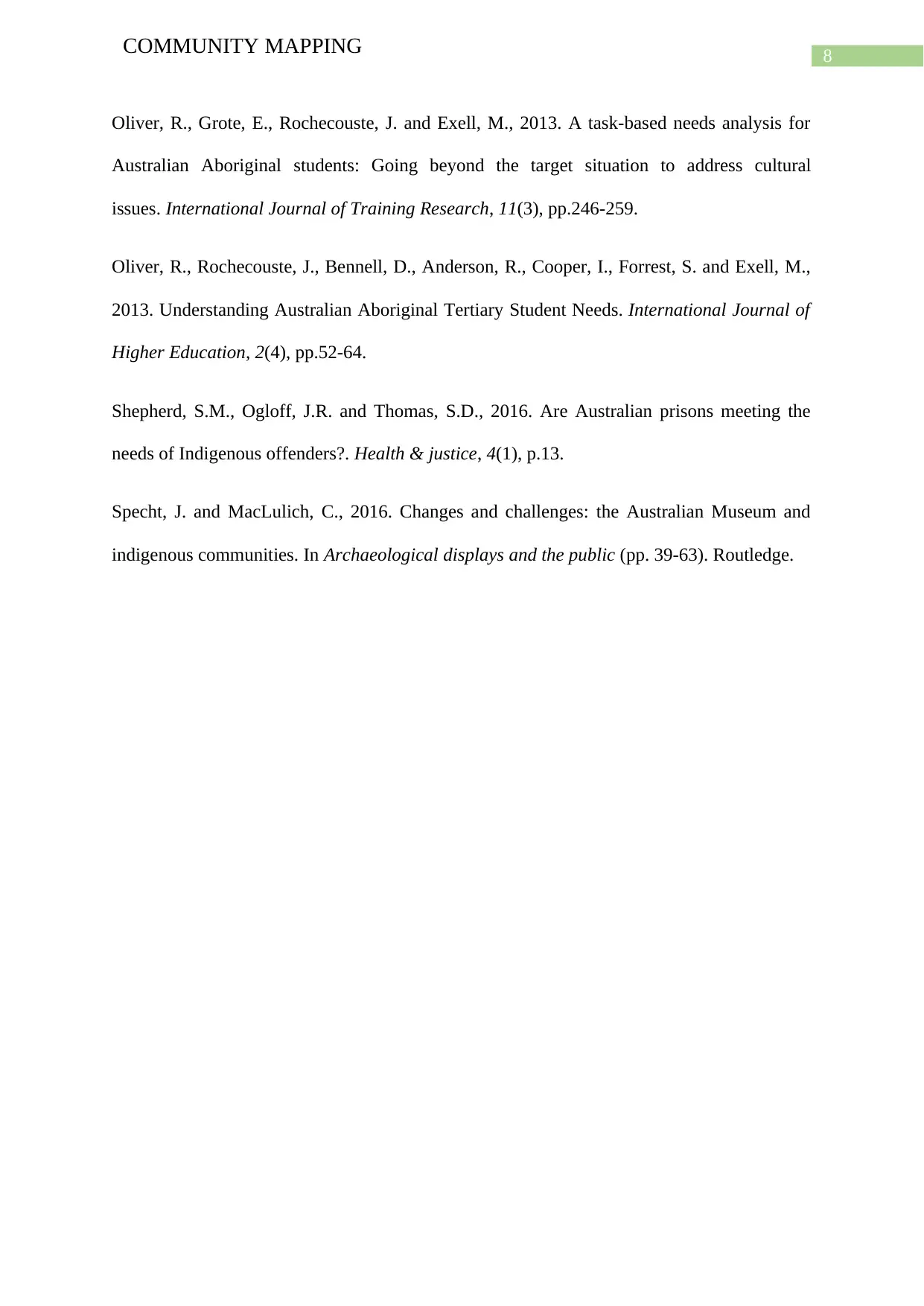
8
COMMUNITY MAPPING
Oliver, R., Grote, E., Rochecouste, J. and Exell, M., 2013. A task-based needs analysis for
Australian Aboriginal students: Going beyond the target situation to address cultural
issues. International Journal of Training Research, 11(3), pp.246-259.
Oliver, R., Rochecouste, J., Bennell, D., Anderson, R., Cooper, I., Forrest, S. and Exell, M.,
2013. Understanding Australian Aboriginal Tertiary Student Needs. International Journal of
Higher Education, 2(4), pp.52-64.
Shepherd, S.M., Ogloff, J.R. and Thomas, S.D., 2016. Are Australian prisons meeting the
needs of Indigenous offenders?. Health & justice, 4(1), p.13.
Specht, J. and MacLulich, C., 2016. Changes and challenges: the Australian Museum and
indigenous communities. In Archaeological displays and the public (pp. 39-63). Routledge.
COMMUNITY MAPPING
Oliver, R., Grote, E., Rochecouste, J. and Exell, M., 2013. A task-based needs analysis for
Australian Aboriginal students: Going beyond the target situation to address cultural
issues. International Journal of Training Research, 11(3), pp.246-259.
Oliver, R., Rochecouste, J., Bennell, D., Anderson, R., Cooper, I., Forrest, S. and Exell, M.,
2013. Understanding Australian Aboriginal Tertiary Student Needs. International Journal of
Higher Education, 2(4), pp.52-64.
Shepherd, S.M., Ogloff, J.R. and Thomas, S.D., 2016. Are Australian prisons meeting the
needs of Indigenous offenders?. Health & justice, 4(1), p.13.
Specht, J. and MacLulich, C., 2016. Changes and challenges: the Australian Museum and
indigenous communities. In Archaeological displays and the public (pp. 39-63). Routledge.
⊘ This is a preview!⊘
Do you want full access?
Subscribe today to unlock all pages.

Trusted by 1+ million students worldwide
1 out of 9
Related Documents
Your All-in-One AI-Powered Toolkit for Academic Success.
+13062052269
info@desklib.com
Available 24*7 on WhatsApp / Email
![[object Object]](/_next/static/media/star-bottom.7253800d.svg)
Unlock your academic potential
Copyright © 2020–2025 A2Z Services. All Rights Reserved. Developed and managed by ZUCOL.




